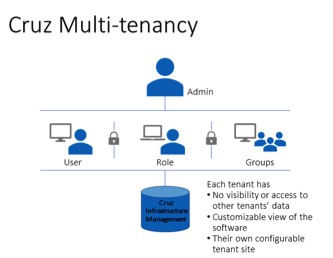First, what is multi-tenancy? With Cruz, it is the ability to have multiple tenants, which can be a user, groups, a company etc., all using a single software instance. This architecture provides significant cost benefits since only a single system requires patch, maintenance or version updates.
Key points
- Tenants have no visibility or access to other tenants’ data.
- Each tenant may have a completely customized view of the software depending on their specific needs.
- Each tenant can further customize and configure their own tenant site.
If your using a single application to manage your datacenter and/or network infrastructure, there are cases where you wouldn't want to give a service customer, a user or an operator full access to your infrastructure management tool. Instead you would provide access to discrete portion of your network and allow specific actions, configuration and views to network data. Here are 3 cases where multi-tenancy may be needed:

1- You’re providing services that span to customer edge devices (CE). For example, an MPLS service may span your infrastructure from the service providers edge (PE) devices up to the CE device. The customer may want access to see the activity, performance, throughput etc., at the CE device for Service Level Agreements. Or, they may need to configure the CE device or ports.
2- As a campus administrator, you may have various computer labs across the campus with switches that are maintained by different area administrators. All may be managed and monitored by software from a central location, but you still want the area administrators to have access to the devices, ports or monitors that they need to manage and maintain their switches.
3- If your infrastructure management application is cloud-based, you may have a large network infrastructure that is geographically dispersed in other time zones.
Due to the size of the network, you need to off load some of the network admin tasks to each region. Each region would have access to a customized set of assets and application functionality. You would want to provide the admin in each region the ability to add their own staff to their tenant site too.
In each case, a multi-tenant site is a good solution. The global administration still has full control to view and manage the entire infrastructure, while discrete tenant sites can be created to allow the tenants the access and control they may require.